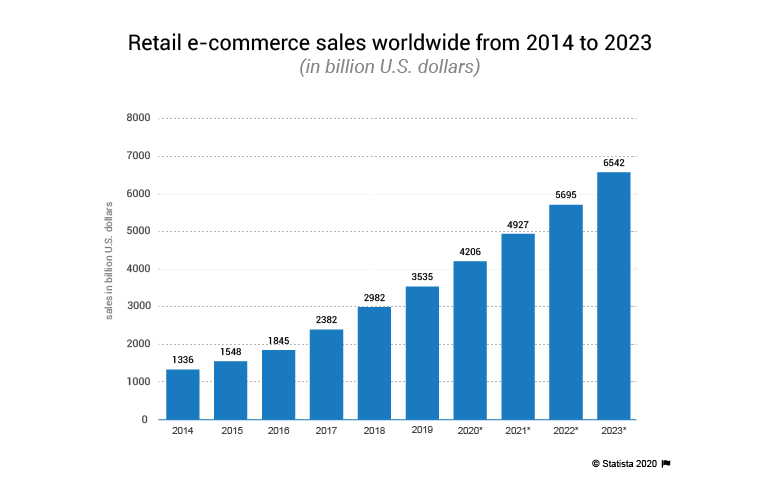Newly evolving trends in e-commerce are changing the realm of the retail industry. These trends bridge the gap between the way retailers sell and the expectations that buyers have. The e-commerce market is progressively developing each year. Let’s see a few facts and figures:
- The global e-commerce market crossed the US$2 trillion thresholds in 2019
- E-commerce revenue represents 10.7% of U.S. retail sales
- Amazon outran Walmart to be the world’s largest retailer
- The global online sales of retail are 16.4%, which includes more than three-quarters of overall retail growth
Considering the pace at which the market is growing these days, it is imperative to adopt the latest trends to stay ahead of the competition. But firstly, it is also important to understand the digital needs of your business to create technical architecture and integration necessities. Digital commerce consulting can help you to identify the complexity of the implementation and give you financial information to support the digital needs of your business.
Do you have an e-commerce sales website? Do you find it difficult to convert visitors into customers?
Here are the latest trends in the global e-commerce market in 2020 that will help you solve these issues. Let’s take a look:
1. Google is not only a search engine but an online marketplace now
Customers reach your website through organic and paid search unless your brand is well-known in the market, in which case, they directly browse your website for required products.
This means you must optimize Google shopping and bring your products in front of more customers. The search engine is an extremely powerful sales channel and you can use it incredibly. When you integrate an open-source e-commerce platform with Google shopping, it creates a PLA (product listing ad). This directly tops the SERPs (search engine results page) on the ‘Shopping’ tab whenever a customer searches for a product that you have listed on your store.
This is extremely beneficial for e-commerce stores, especially the ones that deal with niche products. It’s very easy to get on Google Shopping. You have to set up a Google Merchant Center account and if your online store fulfills the ad requirements, you can start promoting your products via this rewarding channel.
2. People shop via social media
When social media platforms were initially introduced, people used it to connect, share and like messages and pictures. But over the period, social media has evolved and people have started using it for online business purposes as well.
Some social channels are turning into tiny search engines and a lot of shoppers buy products directly through a social post of a brand. Social media platforms have built-in embedded links on their social pages to facilitate e-commerce stores in direct selling of their products. With this, customers can click on a particular product in a post and reach the product page with a click. This method of online advertising also helps in increasing the impulse buys ratio.

3. Use of AR and VR is more in practice
Nowadays, many people prefer online shopping over visiting a store. But there are a lot of reasons for which customers still hesitate to shop online. One of the reasons is that they cannot visualize a product the way they want to see before buying. This makes it difficult to sell clothing, furniture and other accessories online.
The use of augmented reality (AR) and virtual reality (VR) is a new digital commerce trend that caters to these needs of customers by making it possible for the customer to try or choose a product without touching them physically before making a purchase.
Let’s see a few examples where companies are using AR and VR to enhance customer experience:
- Warby Parker, an American online retailer of prescription glasses and sunglasses, has launched an app that uses AR and enables customers to try on different glasses before making a purchase.
- Amazon, the American multinational technology company and Ikea, the European multinational group that deals with furniture, kitchen appliances and home accessories, etc. also use similar technologies to help buyers visualize how pieces of furniture will look in their homes.
By 2021, early adopter brands that redesign their websites to support visual and voice search will increase digital commerce revenue by 30%. – Gartner
4. Chatbots increase revenue generation
Chatbots answer general queries and provide product information and save time for your employees. One of the best features of a chatbot is that, customers get a response to their queries round the clock. Chatbots collect customer data, monitor their browsing and buying patterns along with their purchase history and choices and keep your business updated.
Chatbots are now empowered with AI capabilities that help consumers to identify products as per their requirements. They engage customers on the landing page and help them to find what they are looking for. Chatbots improve customer retention, engagement and sales, as well as enhance the shopping experience.
eBay Inc., the American multinational e-commerce corporation, has incorporated a ShopBot with its e-commerce website. This has tripled the number of queries that eBay’s regular inventory search function used to get.
5. Voice commerce makes searching easier
Voice search is leading to an exciting change in consumer behavior. It is becoming popular these days and digital assistants are playing a major role in it. The invention of voice assistants like Amazon Alexa, Microsoft Cortana, Google Assistant and Siri has led to a spread of voice-driven user experiences. They provide the convenience and speed that suits our busy day-to-day lives.
Retailers consider voice search as another important communication channel that helps to bring clients closer to their brand and products.
Insider Trends reports that using these devices enables “a much more personal and intimate exchange,” between the brand and the consumer and that this offers “a lot of scope for retailers to personalize the interactions.”
Canalys, a marketing research firm stated that around 100 million smart speakers were used last year and the number is predicted to reach 225 million this year.
Since voice-powered purchases have gained so much popularity, many brands are expected to redesign their websites in the near future to support voice search features.
The final say
It’s true that trends empower businesses, capture the industry and impact the buying patterns. E-commerce companies must stick to the trends that help them in improving customer experience and conversions. These trends are evolving and giving incredible returns to e-commerce stores. Have you adopted a digital commerce strategy for your e-commerce business yet? To find out more information on digital commerce trends, talk to our experts.









